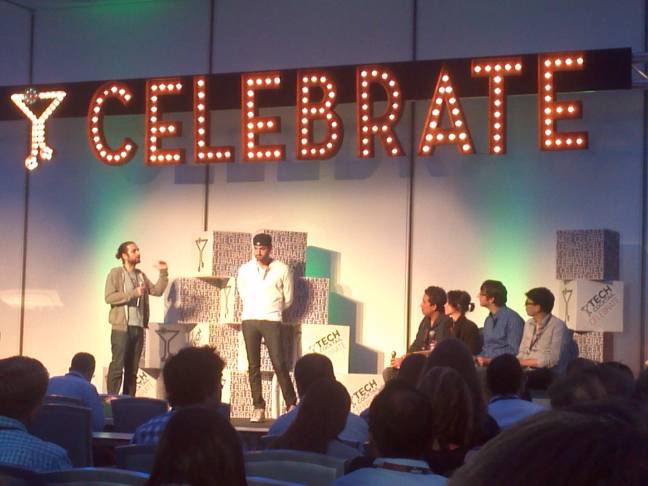I’ve spent some time this week at the Tech.co Celebrate event in Las Vegas, NV. Celebrate is an annual startup competition, where hundreds of startups around the US competed at regional pitch competitions to win a chance to attend the national competition here in Las Vegas. Those hundreds of pitches were narrowed down to 24 finalists who have been pitching here before a panel of experienced investors and entrepreneurs from Silicon Valley.
It’s a fun competition and a great event. The $10,000 cash prize, airline miles, and other prizes they are giving away could really help out some of these startups, and others have already earned enough investment that the dollars may not help, but the exposure certainly will.
Every time you pitch your company should be a learning experience, and hopefully you will be really good at it before you make it to an event like this. Pitch competitions are a little bit of a beauty pageant, and appearances matter just as much as your ideas unfortunately. I don’t mean physical attractiveness of course, but how you present your startup. With that in mind, here are 3 ways I’ve seen to make your startup pitch, and 3 ways to break it.
3 ways to break your startup pitch
Any one of these 3 mistakes can kill your pitch in a heartbeat.
Break #1: Bad opening questions
Many public speakers start a talk with questions like “How many people here have heard of XYZ?” This can work well in some situations, but is also a tired format that can fall flat really dramatically. I saw a pitch start this week with the question “How many people here have ever used a mobile device of some kind, like an iPhone or iPad?” The speaker was looking for everyone to raise their hand, but hardly anybody did because it was such a silly question. In that audience of entrepreneurs and techies, of course every single person has used one, and probably has several. Worse yet, even if everyone had raised their hand, I don’t think it would have added much to her pitch or made me want to use her product anymore.
Break #2: Not answering questions directly
In politics people are taught to never answer someone’s question directly. No matter what you ask a politician, they will nod their head emphatically and then answer the question they wish you had asked instead of what you really asked. While this may work in politics, keep in mind that most of us hate politicians for a reason.
In a startup pitch, you need to present yourself as well versed and confident enough to answer any question. Panelists are going to ask tough questions sometimes, but it is never okay to completely ignore the question and say whatever you want. You will be called out on it and it will be painful to watch. It’s fine to spin things a bit, but you still need to start by answering that question directly: “You’re right Judge, that is an obstacle that our startup faces and I don’t have the exact numbers you’re asking for. But here’s what we’ve learned from our customers that tells us that won’t be an issue, or this is how we are going solve that obstacle.”
Break #3: Reading from notes
A startup pitch is the time to put your best face forward. It’s not a time to take less experienced members of the team and say “this will be a great way for you to improve your public speaking skills.” One pitch I saw this week had two people talking, but with an index card in their hand that they frequently referred to. You’ve only got a few minutes of attention from the panelists and the audience, and it’s not that much to ask that you memorize what you want to say. If you need to look at your notes, then you don’t know your startup well enough.
3 ways to make your startup pitch
I hate writing negative blog posts, and the vast majority of the pitches this week have been really great. So let’s talk about a few things you can do to really make your pitch shine.
Make #1: Think on your feet
This is the corollary to my admonition above about reading from your notes. One of the pitches that I saw in the regional DC competition was going really well until the entrepreneur forgot the next line of his over-memorized pitch. Without the crutch of his perfectly memorized speech, his face went blank and he couldn’t continue. He froze and left the stage. The organizers were very nice and at the end of the other pitches, they let the co-founder of that same startup return to the stage and re-give their pitch.
You’ve got to be able to think on your feet, and this is a good reason to pick the best public speaker on your team. You’re going to get some oddball questions from judges or the audience, you may run out of time and have to compress your pitch, or you might finish early. Or you just might forget what you were going to say next. Never say “I forget”, just move onto another topic without anyone even noticing. I know this is not an easy thing to do, and I can tell you from my personal experience that it takes a good amount of public speaking to get comfortable with thinking on your feet. But it’s worth the time taken to practice. Practice a lot and in front of others as often as you can.
Make #2: Tell your personal story – briefly
One company at this pitch competition makes 3D software for education. It was only in the Q&A session that it came out that the co-founder was legally blind as a child and so is now fascinated by being able to see in 3d. Wow – what a personal story! Their product is not targeted towards the vision-impaired, but this bit of personal information still conveys a passion for what they do that would have improved their pitch a lot in my opinion.
Your personal story doesn’t need to be that dramatic. Another startup at this competition, iLumi.co, makes high end LED lighting that can be controlled from your mobile device. The co-founder said that he was destined for this startup because as a child “light” was his first word. It was a simple joke but played well into his passionate description of their product.
Make #3: Use humor effectively
One of my favorite pitches this week was for a product called Earmark It. I thought the founder did a great job of describing the product and the various pivots in the business model he had made since the original concept. But the standout part was the incredibly cute video of his daughter using the product. The video is well done, funny, and conveys their product concept well. Earmark is not at all for little kids, but that’s what makes the video so great and still so effective.










